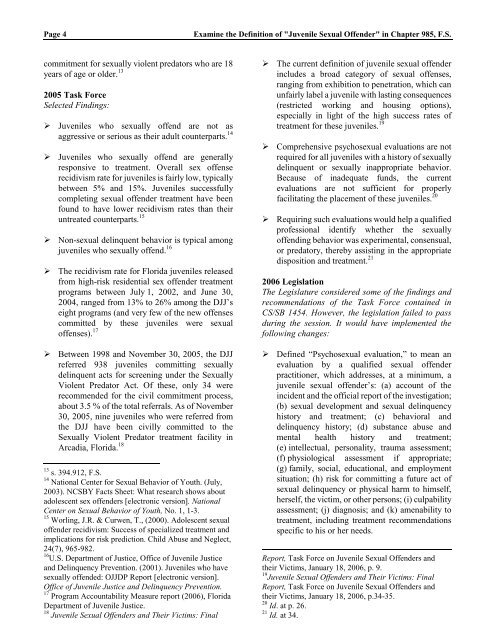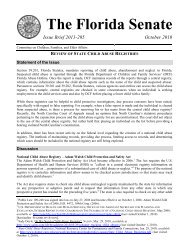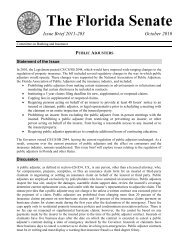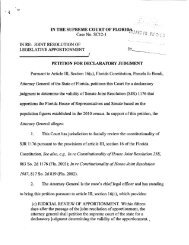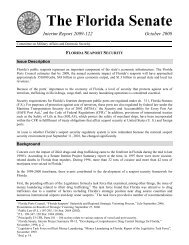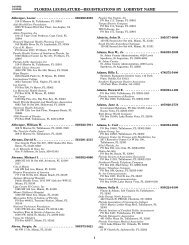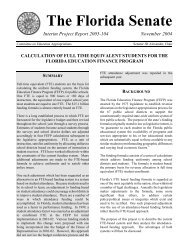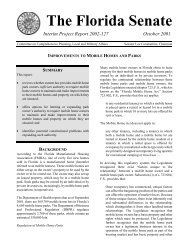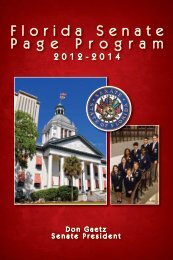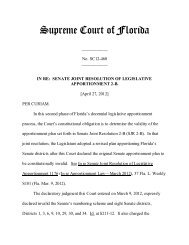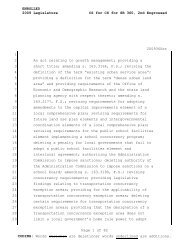"Juvenile Sexual Offender" in Chapter 985, FS - The Florida Senate
"Juvenile Sexual Offender" in Chapter 985, FS - The Florida Senate
"Juvenile Sexual Offender" in Chapter 985, FS - The Florida Senate
You also want an ePaper? Increase the reach of your titles
YUMPU automatically turns print PDFs into web optimized ePapers that Google loves.
Page 4<br />
Exam<strong>in</strong>e the Def<strong>in</strong>ition of "<strong>Juvenile</strong> <strong>Sexual</strong> Offender" <strong>in</strong> <strong>Chapter</strong> <strong>985</strong>, F.S.<br />
commitment for sexually violent predators who are 18<br />
years of age or older. 13<br />
2005 Task Force<br />
Selected F<strong>in</strong>d<strong>in</strong>gs:<br />
‣ <strong>Juvenile</strong>s who sexually offend are not as<br />
aggressive or serious as their adult counterparts. 14<br />
‣ <strong>Juvenile</strong>s who sexually offend are generally<br />
responsive to treatment. Overall sex offense<br />
recidivism rate for juveniles is fairly low, typically<br />
between 5% and 15%. <strong>Juvenile</strong>s successfully<br />
complet<strong>in</strong>g sexual offender treatment have been<br />
found to have lower recidivism rates than their<br />
untreated counterparts. 15<br />
‣ Non-sexual del<strong>in</strong>quent behavior is typical among<br />
juveniles who sexually offend. 16<br />
‣ <strong>The</strong> recidivism rate for <strong>Florida</strong> juveniles released<br />
from high-risk residential sex offender treatment<br />
programs between July 1, 2002, and June 30,<br />
2004, ranged from 13% to 26% among the DJJ’s<br />
eight programs (and very few of the new offenses<br />
committed by these juveniles were sexual<br />
offenses). 17<br />
‣ Between 1998 and November 30, 2005, the DJJ<br />
referred 938 juveniles committ<strong>in</strong>g sexually<br />
del<strong>in</strong>quent acts for screen<strong>in</strong>g under the <strong>Sexual</strong>ly<br />
Violent Predator Act. Of these, only 34 were<br />
recommended for the civil commitment process,<br />
about 3.5 % of the total referrals. As of November<br />
30, 2005, n<strong>in</strong>e juveniles who were referred from<br />
the DJJ have been civilly committed to the<br />
<strong>Sexual</strong>ly Violent Predator treatment facility <strong>in</strong><br />
Arcadia, <strong>Florida</strong>. 18<br />
13 s. 394.912, F.S.<br />
14 National Center for <strong>Sexual</strong> Behavior of Youth. (July,<br />
2003). NCSBY Facts Sheet: What research shows about<br />
adolescent sex offenders [electronic version]. National<br />
Center on <strong>Sexual</strong> Behavior of Youth, No. 1, 1-3.<br />
15 Worl<strong>in</strong>g, J.R. & Curwen, T., (2000). Adolescent sexual<br />
offender recidivism: Success of specialized treatment and<br />
implications for risk prediction. Child Abuse and Neglect,<br />
24(7), 965-982.<br />
16 U.S. Department of Justice, Office of <strong>Juvenile</strong> Justice<br />
and Del<strong>in</strong>quency Prevention. (2001). <strong>Juvenile</strong>s who have<br />
sexually offended: OJJDP Report [electronic version].<br />
Office of <strong>Juvenile</strong> Justice and Del<strong>in</strong>quency Prevention.<br />
17 Program Accountability Measure report (2006), <strong>Florida</strong><br />
Department of <strong>Juvenile</strong> Justice.<br />
18 <strong>Juvenile</strong> <strong>Sexual</strong> Offenders and <strong>The</strong>ir Victims: F<strong>in</strong>al<br />
‣ <strong>The</strong> current def<strong>in</strong>ition of juvenile sexual offender<br />
<strong>in</strong>cludes a broad category of sexual offenses,<br />
rang<strong>in</strong>g from exhibition to penetration, which can<br />
unfairly label a juvenile with last<strong>in</strong>g consequences<br />
(restricted work<strong>in</strong>g and hous<strong>in</strong>g options),<br />
especially <strong>in</strong> light of the high success rates of<br />
treatment for these juveniles. 19<br />
‣ Comprehensive psychosexual evaluations are not<br />
required for all juveniles with a history of sexually<br />
del<strong>in</strong>quent or sexually <strong>in</strong>appropriate behavior.<br />
Because of <strong>in</strong>adequate funds, the current<br />
evaluations are not sufficient for properly<br />
facilitat<strong>in</strong>g the placement of these juveniles. 20<br />
‣ Requir<strong>in</strong>g such evaluations would help a qualified<br />
professional identify whether the sexually<br />
offend<strong>in</strong>g behavior was experimental, consensual,<br />
or predatory, thereby assist<strong>in</strong>g <strong>in</strong> the appropriate<br />
disposition and treatment. 21<br />
2006 Legislation<br />
<strong>The</strong> Legislature considered some of the f<strong>in</strong>d<strong>in</strong>gs and<br />
recommendations of the Task Force conta<strong>in</strong>ed <strong>in</strong><br />
CS/SB 1454. However, the legislation failed to pass<br />
dur<strong>in</strong>g the session. It would have implemented the<br />
follow<strong>in</strong>g changes:<br />
‣ Def<strong>in</strong>ed “Psychosexual evaluation,” to mean an<br />
evaluation by a qualified sexual offender<br />
practitioner, which addresses, at a m<strong>in</strong>imum, a<br />
juvenile sexual offender’s: (a) account of the<br />
<strong>in</strong>cident and the official report of the <strong>in</strong>vestigation;<br />
(b) sexual development and sexual del<strong>in</strong>quency<br />
history and treatment; (c) behavioral and<br />
del<strong>in</strong>quency history; (d) substance abuse and<br />
mental health history and treatment;<br />
(e) <strong>in</strong>tellectual, personality, trauma assessment;<br />
(f) physiological assessment if appropriate;<br />
(g) family, social, educational, and employment<br />
situation; (h) risk for committ<strong>in</strong>g a future act of<br />
sexual del<strong>in</strong>quency or physical harm to himself,<br />
herself, the victim, or other persons; (i) culpability<br />
assessment; (j) diagnosis; and (k) amenability to<br />
treatment, <strong>in</strong>clud<strong>in</strong>g treatment recommendations<br />
specific to his or her needs.<br />
Report, Task Force on <strong>Juvenile</strong> <strong>Sexual</strong> Offenders and<br />
their Victims, January 18, 2006, p. 9.<br />
19 <strong>Juvenile</strong> <strong>Sexual</strong> Offenders and <strong>The</strong>ir Victims: F<strong>in</strong>al<br />
Report, Task Force on <strong>Juvenile</strong> <strong>Sexual</strong> Offenders and<br />
their Victims, January 18, 2006, p.34-35.<br />
20 Id. at p. 26.<br />
21 Id. at 34.


